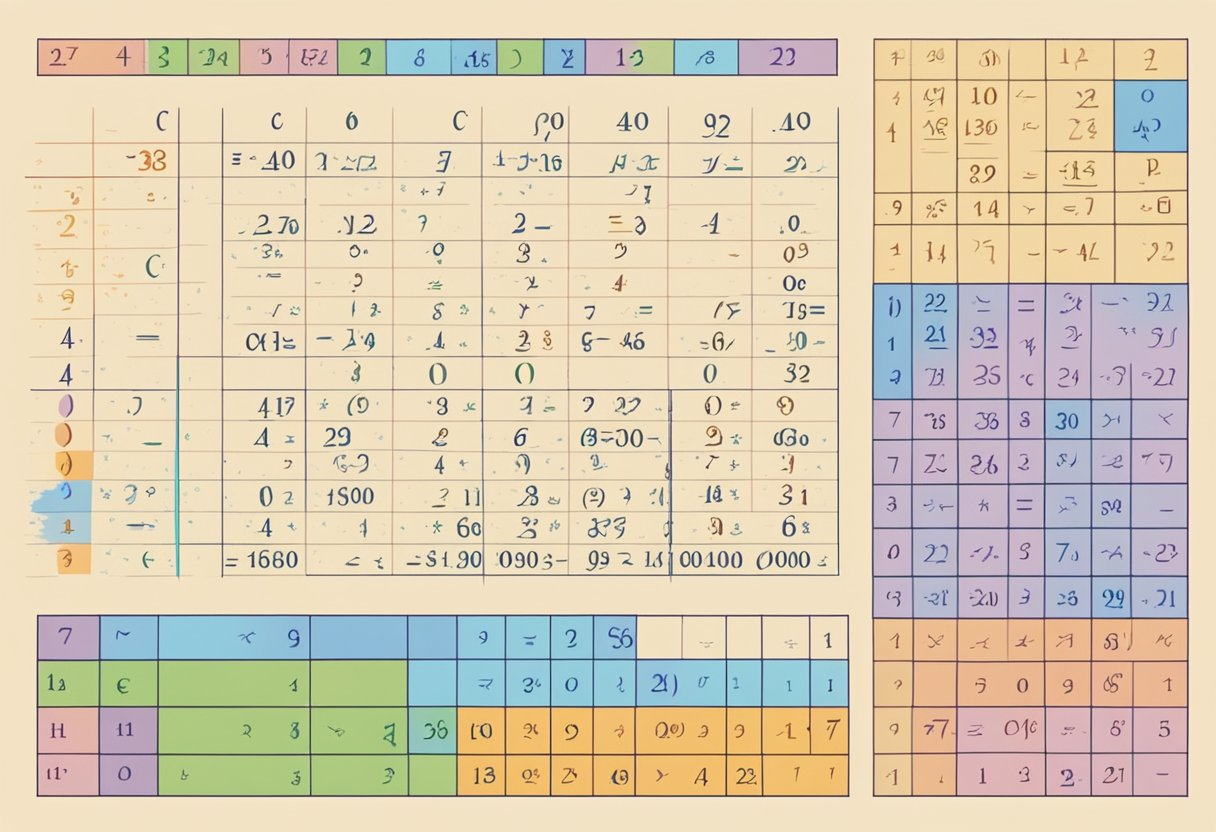- Research platform
Sources of information
Data analysis
Actions
- Solutions
For whom
Problems / Issues
- Materials
Materials
- About us
About us
If you have been exposed to mathematics, or are currently studying mathematics, you have probably heard of the arithmetic mean. It is one of the basic statistical measures that allows you to calculate the average value for a set of numbers. The arithmetic mean is one of the simplest ways to describe numerical data.

The definition of the arithmetic mean is simple. It is the sum of all the values in a set of values divided by the number of values. The formula for calculating the arithmetic mean is: sum of values / number of values. For example, if you have a set of numbers 2, 4, 6, 8, 10, then the sum of these numbers is 30. Since there are five numbers in this set, the arithmetic mean is 30/5 = 6.
The arithmetic mean is one of the basic statistical measures that allows you to calculate the average value for a set of numbers.
The formula for calculating the arithmetic mean is: sum of values / number of values.
The arithmetic mean is one of the simplest ways to describe numerical data.

Arithmetic mean is one of the simplest central measures, used in statistics to describe sets of numbers. It is a value that indicates what the middle value of the average value of all elements in a given set is.
The arithmetic mean is calculated by dividing the sum of all values in a set by the number of those values. The formula for the arithmetic mean is:
Where:
x1, x2, ..., xn are the values in the set of
n is the number of values in the set
The arithmetic mean is a very popular central measure because it is easy to calculate and interpret. It is often used in various fields such as statistics, mathematics, finance, social sciences and economics.
It is worth remembering that the arithmetic mean can be distorted by outliers in the set that are significantly larger than typical, or smaller than the typical rest of the values in data set. Therefore, the value may be less representative than typical of sets that contain extreme values.

The arithmetic mean is one of the simplest statistical measures, which allows you to calculate the average value for a given set of numbers. The formula for calculating the arithmetic mean is very simple and can be written as follows:
Arithmetic mean = (sum of numbers) / (number of numbers)To calculate the arithmetic mean of typical number, you need to add together all the numbers in the set, and then divide the sum by the number of numbers. For example, if you want to calculate the arithmetic mean for the numbers 3, 5, 7 and 9, you should use the formula:
Arithmetic mean = (3 + 5 + 7 + 9) / 4 = 6In this case, the sum of two extremes the numbers is 24, and the number of numbers is 4. Dividing the sum by the number of numbers gives the value of the arithmetic mean, which is 6.
It is worth noting that the formula for calculating the arithmetic mean of two quantitiesis universal and can be applied to any set variable quantity of numbers. Thus, you can easily calculate the arithmetic mean for any number of data, whether it is a few numbers or a few hundred.
The arithmetic mean is one of the most important concepts in statistics and mathematics. Many areas of life use this measure of population evaluation to determine average price values. Here are some examples of the uses of the arithmetic mean.
In statistics, the arithmetic mean is one of the most commonly used indicators. It is used to determine the average value of a given set of data. An example would be to find the average number of number of grades in a given subject. Then the arithmetic mean allows you to determine how well students did in a given subject.
In the sciences, the arithmetic mean is used to determine the average result of an experiment or study. This allows scientists to better understand what the results of their research are and what conclusions are drawn from them.
In commercial research, the arithmetic to find the average of of two quantities of numbers can be used, for example, to determine the average value of sales or the average contents of income. This allows entrepreneurs to better understand what the middle value of their financial performance is and what actions to take to improve performance between two middle values.

The arithmetic average is one type of average. There are also other types of averages, such as geometric mean average of, weighted average, harmonic average and quadratic average. Each of these types of averages has its own use and is calculated in a different way. Depending on your needs, use the appropriate average.
The geometric mean is an average that is calculated by multiplying all the numbers in a set and then taking the nth degree root of the product. The geometric mean is used in cases where we want to calculate an average value that is proportional to all the numbers in a set. For example, if we want to calculate the average value of the average age or average height of children in a class, the geometric mean may be more appropriate than the arithmetic mean.
A weighted average is an average in which each value in a set is multiplied by a weight and then divided by the sum of the weights. The weighted average is used when we want to assign two or more numbers of weight to certain values in a set. For example, if we want to calculate the average of grades in a class, we might assign more weight to grades on final exams than to grades on homework.
The harmonic mean is an average that is calculated by dividing the number of elements in a set by the sum of the inverse of each value in the set, and then taking the inverse of the result. The harmonic mean is used when we want to calculate the average value that is inversely proportional to each value in the set. For example, if we want to calculate the average speed, the harmonic mean may be more appropriate than the arithmetic mean.
The root mean square is an average that is calculated by adding the square of each value in the set and then dividing the sum by the number of elements in the set. From the last result obtained, the root must be drawn. The mean squared is used when we want to calculate the average value that is proportional to the square of each value in the set. For example, if we want to calculate the average value of the temperature during the average day here, the quadratic mean may be more appropriate than the arithmetic mean.

The arithmetic mean is a basic mathematical concept that is used in many areas of life. Calculating the arithmetic mean is simple and involves adding up all the elements of a set and dividing by their number. In this section, we will present some examples of calculating the arithmetic mean.
Calculating the arithmetic mean for a set of negative numbers. Suppose you have a set of numbers -2, -4 and -6. In this case, too, you need to add up all the numbers and divide by their number. The sum is -12, and the number of numbers is 3. Thus, it follows that the arithmetic mean is -4.
Another example is to calculate the arithmetic mean for a set of fractional numbers. Suppose you have a set of numbers 1/2, 1/4 and 3/4. In this case, too, you need to add up all the numbers and divide by their number. The sum is 1.5, and the number of numbers is 3. Thus, it follows that the arithmetic mean is 0.5.
The last example is to calculate the arithmetic mean for a set of measurable numbers. Suppose you have a set of numbers 2.5, 3.5 and 4.5. In this case, too, you need to add up all the numbers and divide the total by the number of total by the number of their number. The sum is 10.5, and the number of numbers is 3. Thus, it follows that the arithmetic mean is 3.5.
Calculating the arithmetic mean is simple and requires only basic mathematical knowledge.
Calculating the arithmetic mean is a basic statistical operation, but even with such a simple task such an expense one, mistakes can be made. Below are the most common pitfalls to watch out for:
1. Failure to include all values
The arithmetic mean of word average is sensitive to missing values. If you omit any variable quantity of data, the result of term average will be underestimated. Therefore, before calculating the average, make sure you include all values.
2. Incorrect rounding
Rounding the result to too few decimal places can lead to errors. On the other hand, too much precision can suggest the average person that the result is more precise than the average person that it really is. Therefore, it's a good idea to use moderation when rounding results.
3. Failure to take weights into account
The arithmetic mean does not take into account the weights of individual values. If some values are more significant than others, then a weighted average of middle values should be used. In this case, each value is multiplied by its average weight, and then all the values are added up and divided by the sum of the average weights of lowest values.
4. Consideration of outliers
Extreme values, such loss, or outliers, can significantly affect the average performance and the result of the average. Therefore, it is worth checking the averages for such values and adjusting the data if necessary. You can also use averages or a breakaway average, which eliminates extreme values.
5. Failure to take units into account
When calculating the arithmetic numerical average amount, it is important to remember the units in which the values are expressed. If the values have different units, they should be converted to a single unit, such as meters or kilograms. Otherwise, the numerical average result may be incomparable and incorrect.
In marketing research, the arithmetic mean is one of the most commonly used indicators. It is a simple method of calculating the average value, which allows you to determine the average value of all the interested parties' research results. The arithmetic mean is particularly useful when quantitative data, such as sales numbers, prices, duration, etc., are studied.
In UX research, the arithmetic mean can be used to determine the average response time of users to interact with the interface. For surveys, the arithmetic mean can be used to calculate the average age of response to a question, giving an overall idea of respondents' opinions.
In order to obtain accurate results, it is important to collect a sufficient number of samples. The larger the number of samples, the more accurate the results will result obtained. In addition, it is important to collect samples that are representative of the entire population to avoid errors due to random sampling.
In conclusion, the arithmetic mean is an important tool in marketing research to get an overall picture based on survey results. By using the right number of samples and collecting them in a representative manner such a workload does, you can get accurate results that will help you make business decisions.
The formula for calculating the arithmetic mean is the sum of all numbers in a set divided by the number of numbers in that set. It can be written as: x = (a1 a2 a3 ... an) / n, where x is the arithmetic mean, a1 to an are the numbers in the set, and n is the number of elements in the set.
The arithmetic mean and median are two different central measures in statistics. The arithmetic mean is the sum of all numbers in a set divided by the number of numbers in that set. The median is the middle number in a set, that is, the number that divides typical single number in the set into two equal parts. This means that 50% of the numbers in the set are less than or equal to the median, and 50% are greater than or equal to the median. If the set has an even number of elements, the median is the arithmetic mean of the two middle numbers.
The arithmetic mean is commonly used in practice, such as in finance, economics, statistics, science and engineering. In finance, the arithmetic mean is used to calculate the average return on investment. In economics, the arithmetic mean is used to calculate average income or expenses. In science and engineering, the arithmetic mean is used to calculate the average value of measurements or experimental results.
Copyright © 2023. YourCX. All rights reserved — Design by Proformat